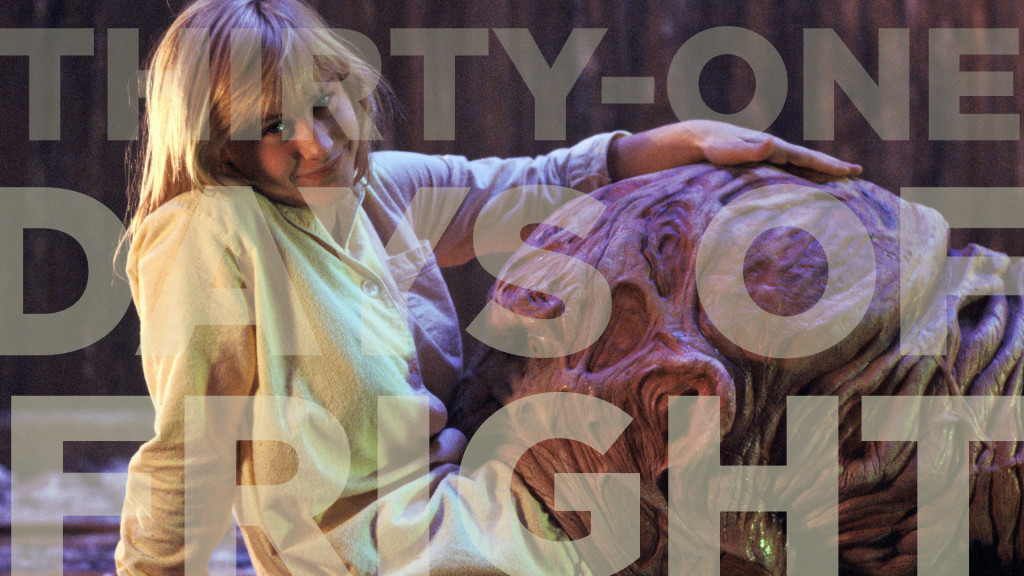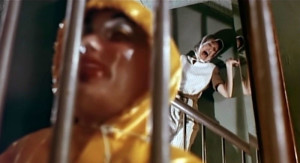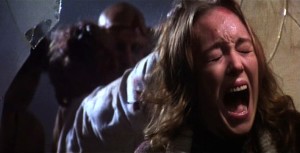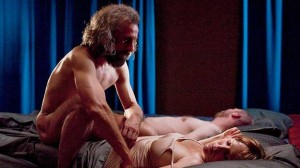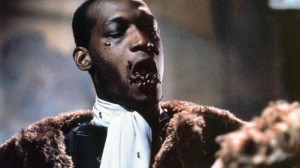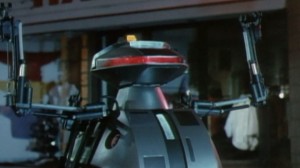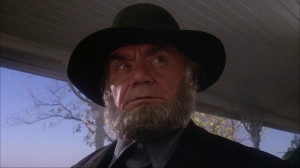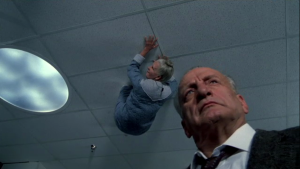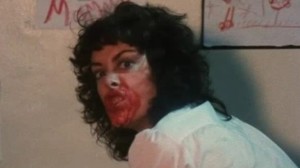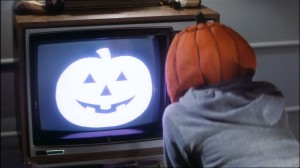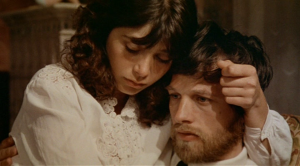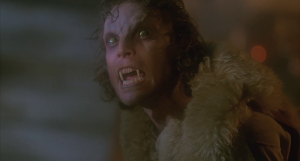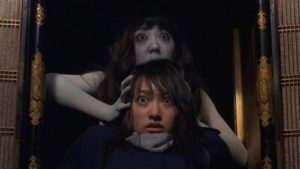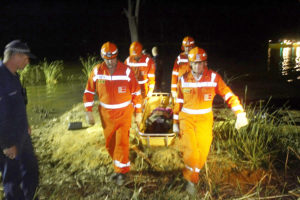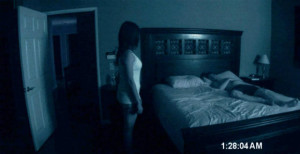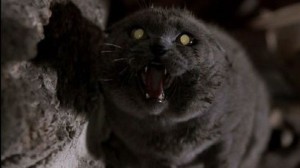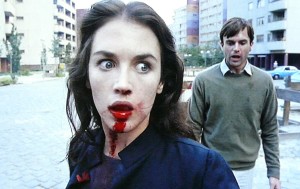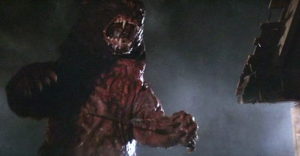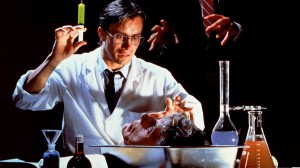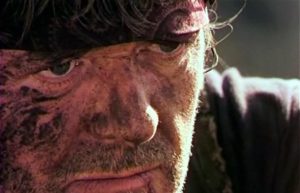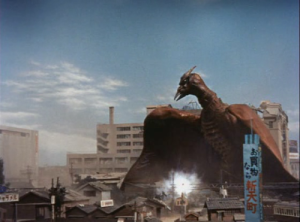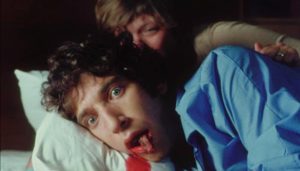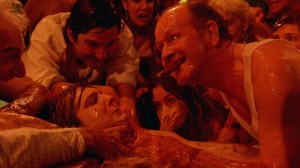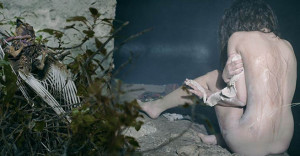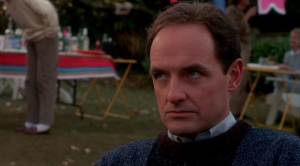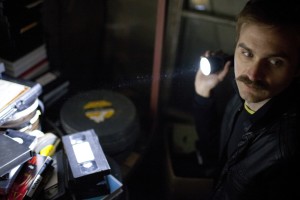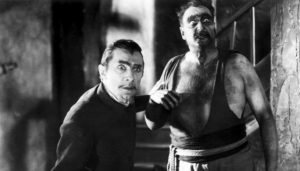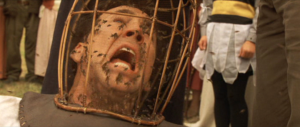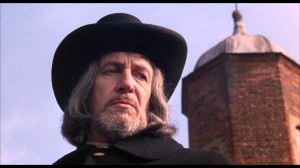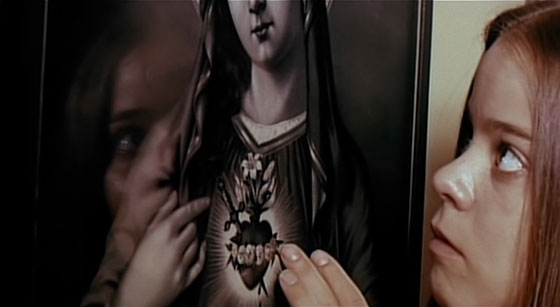
Is Alice, Sweet Alice scary? Is the Pope Catholic?
This January, in support of the Toronto Rape Crisis Centre / Multicultural Women Against Rape, friends and family have raised over $1,000, which means I have to watch and write about thirty-one horror movies. I’ll watch (on average) one movie a night, many of them requested by donors, after which I’ll write some things about said movies on this website. Be forewarned that all such write-ups will contain spoilers! Last night’s movie was the eerie Alice, Sweet Alice (originally titled Communion), directed by Alfred Sole (director of Pandemonium and production designer of Veronica Mars!). The film was another of those unspoken-for evenings. (I had heard this was a creepy one.) Alice, Sweet Alice was rented from the excellent folks at Queen Video.
What happens:
Alice, Sweet Alice was originally titled Communion (for reasons that will soon become obvious), and later renamed Holy Terror (ditto). The film’s title sequence features a girl in a white veil reciting the Lord’s prayer as the opening credits cycle past. With the appearance of the director’s name, the girl brandishes a knife, and the film proper begins. The year is 1961, and the place is Paterson, New Jersey. Catherine Spages (Linda Miller) a single mother and her two young daughters – the angelic Karen (Brooke Shields) and the slightly strange Alice (Paula E. Sheppard) – arrive at the home of local Catholic priest, Father Tom (Rudoph Willrich). Karen is about to have her first communion and the youngish, hip Father Tom has bought her a a gold crucifix. Alice, meanwhile, sneaks off down the hallway, fondles a portrait of the Virgin Mary, then dons a spooky translucent mask and terrifies Mrs. Tredoni (Mildred Clinton), Father Tom’s housekeeper and church assistant. Catherine reprimands her eldest daughter for scaring poor Mrs. Tredoni.
Later, at the Spages’ apartment, Karen, dressed in her yellow school raincoat, runs in tears to her mother. She says that Alice has taken the doll her father gave her and won’t give it back. Seeking her doll, Karen pursues Alice to a derelict building, where Alice, in her nightmarish mask, leaps out from behind a dangling light fixture and startles her. Alice removes the mask, revealing an even creepier mask underneath. Alice locks her younger sister in a room in the building and warns her that if she tells anyone what she’s done, Karen will never see the doll again. Throughout the opening, it’s clear that Alice is envious of her younger sister, who most friends and family view as a kind of golden child. Alice has grown too old and strange to be quite as beloved. For instance, Alice tries on Karen’s communion veil and Alice whines that her sister is ruining it. Their mother, naturally, takes Karen’s side.
We soon meet Mr. Alphonso (Alphonso DeNoble), the Spages’ plus-size landlord who always seems to have a prominent stain on the crotch of his pants. He turns on his phonograph and shares a meal of cat food with his many kitten “babies.” (And by “share,” I mean he eats half the cat food himself.) As Alice leaves the building, he tries to get her to pick up some items from the store, but she calls him a “fatso” and runs away.
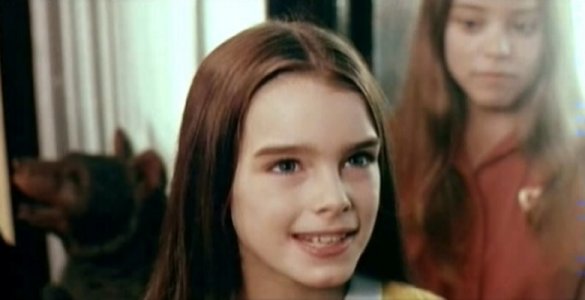
Suddenly Susan? More like Suddenly Murdered at her own First Communion.
At Karen’s first communion, Annie DeLorenze (Jane Lowry), Catherine’s sister and professional busybody, and her husband Jim (Gary Allen) come to church to witness the big day. Alice is nowhere to be found, so they send their daughter, Angela (Kathy Rich), to find her outside. While the other children receive communion, someone in a yellow slicker and translucent mask chokes Karen to death with a candlestick in the back room. The killer then pushes Karen’s body across the church floor (instead of dragging it), puts her body into a church bench, removes her new crucifix, and sets the bench on fire. Communion continues, with Catherine showing no sign of concern that her daughter doesn’t seem to be part of the festivities. Her other daughter, Alice, however, has donned a veil and taken a spot in the communion line. A nun smells smoke and runs backstage to investigate. She screams just as Father Tom is about to place the host on Alice’s tongue.
Annie goes to investigate the source of the screams and finds Karen’s burned body. She hollers and total panic erupts in the church. Catherine is about to leave with Alice until her sister stops her and tells her that Karen is dead. Father Tom steps from the rear of the church and the grim look on his face tells Catherine all she needs to know. She falls apart and begins to sob. Karen’s father, now remarried, Dominic Spages (Niles McMaster), returns to Paterson for the funeral. Dominic and Catherine tearfully embrace and bury their little girl. Detectives Brennan and Spina, staking out the funeral, discuss how they’ll need to interview Alice and the landlord, Alphonso, in particular.
During a wake in the Spages’ apartment, the assembled mourners talk about the downfall of society – how you’re not even safe in the church anymore. Annie offers to stick around for a while and take care of things around the house for a while. The adults instruct Alice to bring a cake to Mr. Alphonso downstairs, and Annie’s kids, Angela and Robert, tag along. Alphonso expresses his condolences, but also laments “too bad she was the one to end up in the box.” Alice, equally hateful of the landlord, brazenly digs her finger into his cake and sucks the icing from her finger. She makes another crack about him being fat and shoves the cake in his direction. While the kids are out of the room, Annie and Jim express suspicions about Alice: she was the last one to enter the church, after all, and she had Karen’s veil. Catherine and Dominic, though, refuse to believe their daughter is capable of murder.
Dominic meets with Detective Brennan (Tom Signorelli) in the police bureau, the walls of which are covered with nude pin-ups. (A relic of another time, I suppose, though I’m not sure when that would have ever been appropriate for a police department.) Brennan would like to interview Alice, and his more aggressive partner, Detective Spina (Michael Hardstark), is even more adamant about it. Dominic doesn’t like their insinuations and says they won’t be talking to his daughter. He storms out. Spina, however, has already spoken to the school principal and obtained Alice’s records. The school made repeated recommendations that Alice see a psychiatrist, but the requests were never acted upon. Brennan scans the school records. “This girl is nuts,” he concludes.
Catherine is busy zoning out in Alice’s bedroom when she hears a crash from the kitchen below. Alice tried to carry a tray that her Aunt Annie warned was too heavy, and now there’s spilled milk and glass all over the floor. Annie yells at Alice over this minor disaster. She also informs Catherine that she feels Alice should return to school right away and not wait until she’s somehow “over” her sister’s death. The conversation erupts into a big verbal squabble, and Catherine sends Alice out of the apartment to deliver the rent cheque to Alphonso. With the door closed, Annie and Catherine talk more freely, with Annie strongly suspecting that Alice knows where Karen’s missing crucifix has gone.
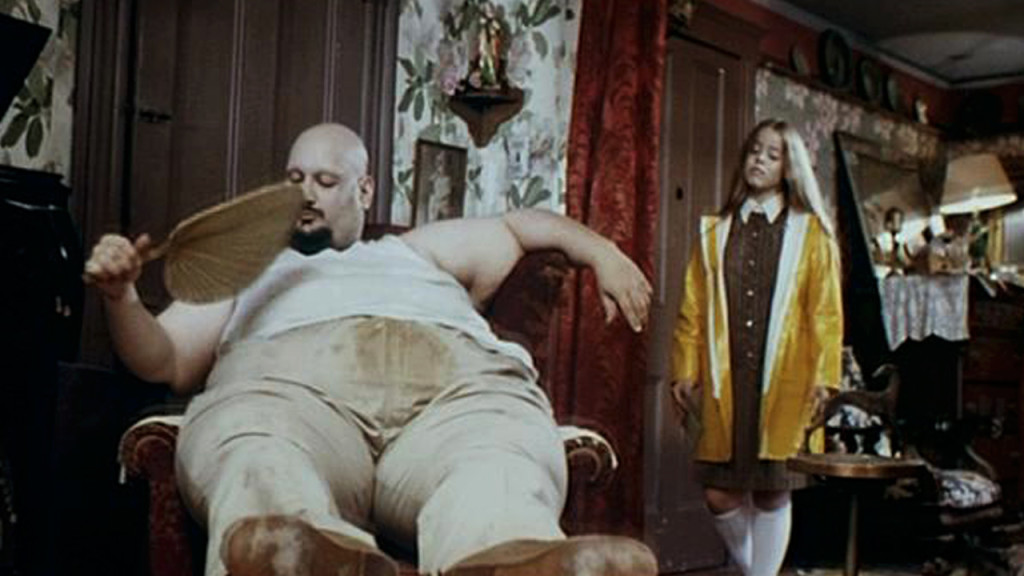
Alphonso is perhaps the words landlord in film since Mr. Roeper.
Alice lets herself into Alphonso’s apartment, where the landlord is fanning himself on the couch like a Jersey Colonel Kurtz. Alphonso suggests that Alice probably hates her aunt and him because they’re both perceptive people and they both realize she had something to do with Karen’s death. Alice crumples the rent cheque into a ball in her fist and Alphonso gets overly upset – “Look what you did to this cheque!” He seizes her arm and threatens to show the police the stuff he’s seen of hers in the basement. Apparently something incriminating. The landlord then begins to make a sexual advance on Alice (who must be about twelve or thirteen), intimating that this has happened once before. (Maybe that’s why Alice hates you, Alphonso.) Alice roughly grabs a nearby cat around the neck and chokes it. Then she spikes the cat on the ground and runs from the apartment. “My baby! You killed my baby!” Alphonso yells and Alice runs down the stairs.
Under shelter in the middle of a rainstorm, Father Tom and Dominic have their “we need to talk about Alice moment. Father Tom notes that Alice has been acting out in school. “She has a knack for making things look like accidents,” he notes. The film cuts back to Alice in the apartment building’s basement, looking over the souvenirs she’s collected in her suitcase: the translucent mask, a jar of cockroaches, Karen’s veil, a crucifix. It’s like a sinister inversion of the opening credits of To Kill a Mockingbird. She dons the mask and closes her suitcase.
Auntie Annie walks downstairs, dressed for the weather, but she’s surprised by an assailant in a yellow raincoat and mask who stabs her a couple times in the thigh, then her foot. “Alice!” Annie screams out. Mr. Alphonso opens his door to see the bloodbath unfolding and the stabber runs away. Catherine runs downstairs and Annie drags her bleeding body into the rainy street. Catherine braves the storm to embrace her and screams out for help, but none arrives. (Shades of Kitty Genovese.) Eventually, Dominic arrives with Father Tom. He sends Annie and his ex-wife to the hospital with the priest, then goes to find his daughter on his own. He finds Alice in that abandoned building, hidden in the locked room where she once locked Karen. Alice is fearful, clutching the two-faced porcelain doll she once stole from her sister. Dominic hugs Alice, saying he loves her.
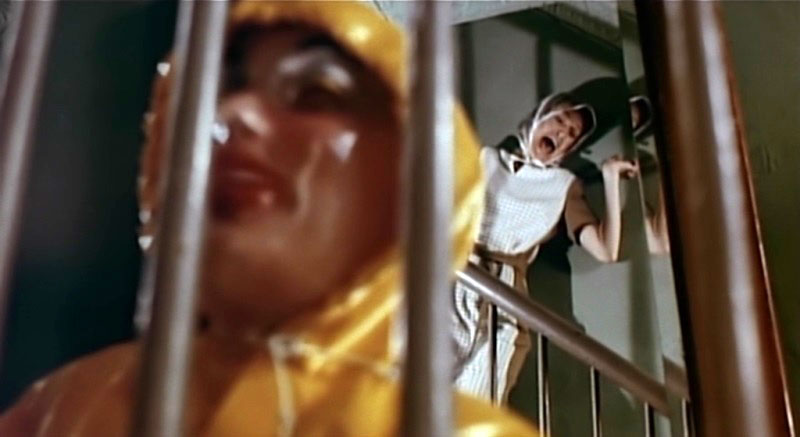
Unusual raingear, but it seems to do the trick.
Catherine goes to visit her wounded sister in the hospital. Father Tom says that Annie claims Alice attacked her, and Mr. Alphonso identified her as the knife-wielder, as well. Catherine, however, persists in her belief in her daughter’s innocence: “People believe what they want to believe.” She goes to Annie’s bedside, where her sister sleeps, and pleads for her to not identify Alice as her attacker. “I will never forgive you if you do this to me!” she shouts. The pock-marked Detective Spina arrives, looking for answers. Annie begins to weep and talk while Catherine berates her. “Shut up, Annie!” she shouts. Annie tells Spina that Alice stabbed her, and Catherine shouts “LIAR!” Catherine claims Annie always hated Alice because Catherine was pregnant with her when she got married. (A child out of wedlock!) But the damage is done; the victim has fingered a suspect.
The police take Alice to the station where they make her submit to a polygraph. Alice claims that it was Karen who stabbed her aunt. The strange thing is, the polygraph tester says, Alice seems to be telling the truth. Then the polygraph tester proceeds to salivate over a twelve-year-old’s chest, claiming “she wanted me to feel her up.” (Serve and protect, folks.) Though she can’t hear their conversation, Alice retaliates by dumping the polygraph machine on the floor. Spina plans to book Alice for arrest, if only to have a psychiatrist see her. Back at the church, Mrs. Tredoni prepares a nice meal for the ancient and doddering Monsignor (Peter Bosche), Father Pat (Patrick Gorman), and Father Tom, but Father Tom is out with Dominic, and his food gets quite cold. Dominic has convinced himself that his niece, Angela, is a prime suspect. After all, she was missing in the church when Karen died, and owns the same raincoat. Father Tom prepares for Dom a list of children who’ve bought the school raincoat, and lends him the use of his car to continue his detective work.
But first, exes Catherine and Dominic have to pay a visit to the children’s shelter, where Alice is being kept under the watch of a psychiatrist. Dr. Whitman (Louisa Horton), interrupted while busily recording audio about a girl with a “schizoid personality,” advises the parents not to pretend that Alice will return home any time soon. Whitman says that Alice feels a great deal of hostility toward her mother, so they should be candid about how long she might have to stay in the shelter. She also reveals to Catherine that Alice has begun menstruating, and kept it secret from her. Catherine and Dominic visit Alice in the shelter courtyard, where Alice begs to go home. Dom promises his daughter that even though he should return to his wife, Julia, he’ll stay until this mystery is solved. He goes to discuss medication with Dr. Whitman, leaving Catherine alone with her daughter, with whom she becomes increasingly resentful. “Why don’t you talk to me?” she moans. Alice refuses Karen’s doll with the two faces, and they part coldly. Catherine just about leaves the courtyard when Alice bursts into tears and runs into her mother’s arms.
Dominic becomes increasingly convinced Annie’s daughter, Angela, is the killer. Catherine, however, tries to ground her ex-husband in reality: Angela is about twice the size of Karen. How would Alice get the two of them confused? They receive a couple of mysterious, silent phone calls while at Catherine’s apartment alone. Dominic promises he’ll make everything all right, and Catherine replies, “Can you?” They fall back into old habits and start to kiss, but are interrupted by a third phone call. This time, it’s Dom’s current wife, Julia, who has interrupted them mid-makeout. Dominic and Catherine rethink their romantic backslide and Catherine suggests he go home to his wife, stop playing detective. (Oh, if only Dom had listened to her!)
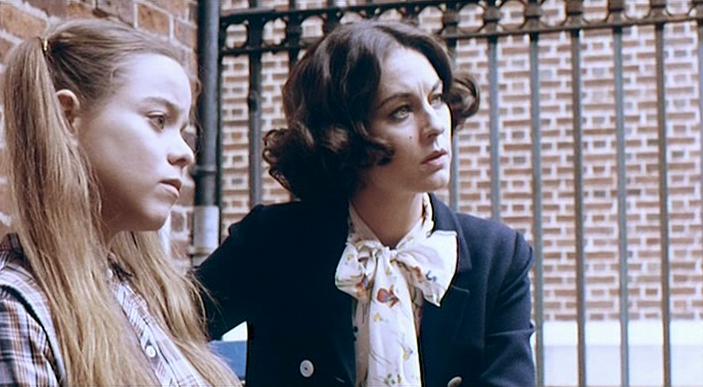
Alice has been institutionalized, but it’s her parents who are living in a prison, man.
Returning to his hotel, Dominic receives another phone call. It’s Angela, completely in a panic, who says she has Karen’s crucifix and is in hiding because her mother won’t let her tell anyone. They make plans to meet up in a safe location. Dominic arrives at what must be Paterson Falls. Atop a bridge spanning the falls, he spots a girl in a mask and yellow raincoat. “Angela, wait!” he yells, and runs after her. He follows “Angela” into a dilapidated building, devoid of everything except some construction refuse and a few dozen pigeons. He ascends the stairs, and at the very top, the raincoated figure leaps out and stabs him in the shoulder. Dom manages to wrest the knife out of her hand, but he falls back on to the ground and very Psycho-esque music swells. After resting a few seconds, Dominic gets to his feet and proceeds to the top floor of the building. He finds the girl in the yellow slicker hiding behind a support beam. “You don’t have to be afraid of me,” Dom insists.
This, however, is far from the issue. The girl hits him in the face with a brick, then again … and again, until he’s knocked unconscious. The assailant opens the loft doors, revealing they are now a few storeys above the ground. She ties Dom up and rolls his partially conscious body to the floor’s ledge. That’s when the killer removes her mask to reveal herself as Mrs. Tredoni! She reveals that stabbing Annie was an accident – she thought it was Catherine (they do look pretty similar), whom she says is a whore. In fact, both Catherine and Dominic are sinners. But she also hates Dom for leaving his whore wife, thus leaving Father Tom susceptible to her seductions. Dominic manages to bite the missing crucifix off of Tredoni’s neck, and Tredoni beats his mouth with the brick in an attempt to retrieve it. Failing, she rolls him out the window to his death. Church bells peal in the distance.
Tredoni prays, still dressed in her schoolgirl raincoat, in the darkened church. The lights turn on and she hears voices, so she hides in the confession booth. Father Tom and a Sunday school group have arrived, for he is aiming to take the children’s confessions. He enters the booth and discovers someone is already in the other side. He recognizes the voice as Mrs. Tredoni’s. She confesses that she gets frustrated with the Monsignor – she should be more patient. Father Tom reassures Tredoni that this is not a mortal sin. She’s a good woman of faith, and that should Tredoni ever have concerns, she can talk to him about them in person.

Father Tom is like that cool young teacher who knows how the kids talk.
Later, Catherine drops by Father Tom’s. He’s not home, but Tredoni is, and she’s (obviously) bothered by her mere presence. Catherine tells Tredoni she’s looking for Dom. She knows he borrowed Father Tom’s car, so she wonders if Tom knows where he’s gone. Tredoni tries to give Catherine the cold shoulder at first, but reluctantly lets her in. She prepares coffee for the woman she considers a whore. Tredoni then tells Catherine about St. Michael, and how he takes the children away to heaven. Like some sort of twisted Catcher in the Rye. Tredoni had a daughter once, who was taken right after her first communion. This death, she says, taught her a lesson: children are punished fro the sins of their parents. Tredoni devoted her life to the Church after that, and specifically, to protecting Father Tom. She emphasizes this last point by waving a fish knife in Catherine’s face. But Tredoni’s threats are interrupted by arrival of news from Father Tom: Dominic has been found murdered.
The detectives are baffled as their prime suspect, Alice, was in the children’s shelter when Dominic died. The medical examiner calls them with an interesting discovery: a crucifix was found in the victim’s throat. Perhaps it matches Karen’s. Father Tom drives Catherine to pick up Alice from the children’s shelter – given her father’s death, she’s no longer under suspicion – and the two debate whether Catherine should tell Alice that her father has died. Catherine decides against it, and instead pretends that Dominic has returned to his wife. Back at Father Tom’s place, Tredoni lies on her scrapbook-strewn bed, wallowing in past memories. She gazes at the glamour shot of Father Tom on her nightstand and grumbles “Catherine.” Tredoni gathers her murdering things, places the gear in a paper shopping bag, crosses herself, and leaves. But not before the out-of-it Monsignor notices her unusual departure.
Detective Mike Spina, who has staked out Father Tom’s street, spots a girl in a yellow raincoat atop a bicycle and quietly follows her in his car. In the Spages’ apartment building, Mr. Alphonso is fast asleep on his couch. A girl in a yellow raincoat and mask enters his apartment. (I guess it was a different era, when people left their doors unlocked. Though I figure if there had been a stabbing in your hallway just days earlier, I might start locking the door.) She opens a jar of cockroaches and leaves it on Alphonso’s prodigious belly. Quietly tiptoeing out of the apartment, she takes off her mask to reveal herself as Alice, playing a childish prank. However, the other raincoated intruder, Mrs. Tredoni, enters the rear of the building just as Alice exits from the front. She goes to the Spages’ door and bangs insistently.
Alphonso screams, awakened by the cockroaches climbing all over his body. He runs out his door and, in his panic, sees who he thinks is Alice on the landing above. He grabs “Alice,” who retaliates by stabbing him twice in his chest and fleeing. Detective Spina, hearing the nearby commotion, tries to enter the building. He has to throw an air conditioner through the window to get inside, where he sees Mrs. Tredoni, in yellow raincoat, scrambling out the back. Spina runs upstairs to find Mr. Alphonso dead, his cats already lapping up his bloodstains. (Typical.)
Tredoni, still wearing the school raincoat, arrives for mass a bit late. Detective Spina arrives with police backup and confers with Father Tom outside. Father Tom, having been informed that his housekeeper is the killer, says that Tredoni is too close to Catherine and Alice at the moment. The police shouldn’t rush in or they might put the two of them in danger. He says that when he gives Tredoni communion, they should enter and arrest her. When they’re placing wafers into the faithfuls’ mouths, Tredoni butts in front of line so she can kneel beside Alice and her mother. Once Catherine is safely back in her seat, Father Tom denies Tredoni communion. “Please come with me, Mrs. Tredoni,” he gently says. Tredoni is outraged that she won’t be given the host. “But you give it to the whore?!” she yells, gesturing toward Catherine.
Mrs. Tredoni pulls the butcher knife from her shopping bag and stabs Father Tom in the neck. He sputters blood all over and Tredoni smiles and embraces the profusely bleeding priest beatifically. And strangely, no one intervenes for a very long time. Finally the police swarm in. Alice walks from the pulpit along the centre aisle in a daze. She holds both Mrs. Tredoni’s shopping bag and the bloodstained knife. In the final shot of the film, she slides the knife into the bag and looks toward the camera.
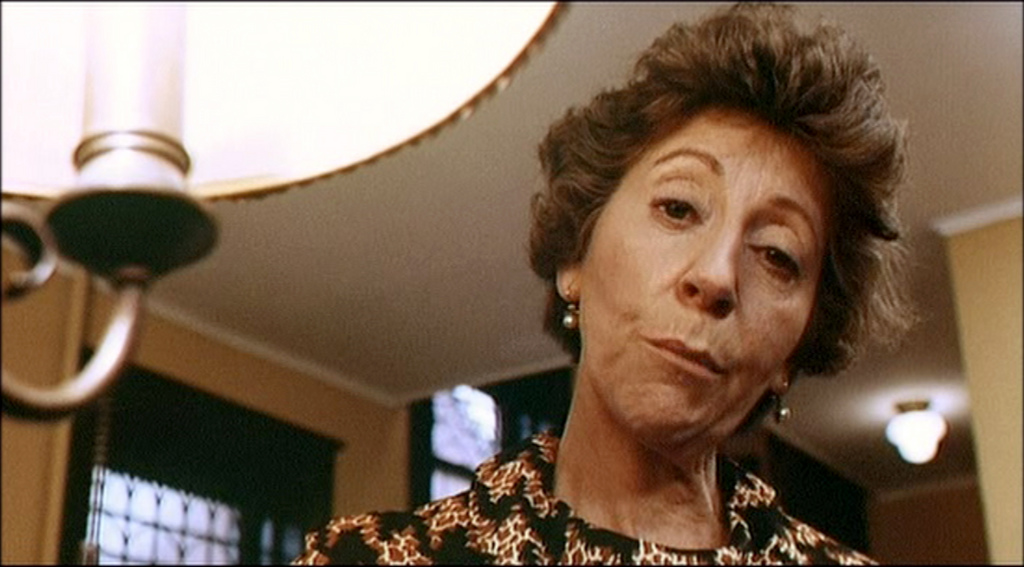
Tredoni’s game face looks a lot like Joey Tribbiani’s soap opera acting face.
Takeaway points:
- The concept of Alice, Sweet Alice relies on the idea that the audience have a natural fear of young girls. And quite explicitly, the sexuality of young girls. Given a movie with so much Catholic iconography, you’ll be unsurprised to note the film falls easily into a Madonna/Whore dichotomy. Karen is the virginal, angelic young sister to Alice, the weird older sister who has begun to menstruate, and whose body adult men – the polygraph tester, the landlord – continually comment on. Karen must die (in Mrs. Tredoni’s eyes) at first communion to save her from the fallen life that Alice and her mother lead. Tredoni also sees the girls’ mother as a whore, engaging in premarital sex. She threatens the faithful life of her saintly Father Tom. (Father Tom, however, seems about a million miles from being interested in women.) Of course, as is common in traditional religion, the men are blameless in the sinning: Alice is “asking” to be felt up, the polygraph tester suggests. Though Tredoni does murder Dominic, not so much for the premarital sex, but for freeing the lusty Catherine to indulge in her desires, husband-free.
- Further to that note, because Alice doesn’t act like people’s notions of what a girl should act like, she falls under suspicion. Alice’s strangeness all but confirms her as the killer. But in reality, what is Alice doing but acting out against the adult men who denigrate her? She treats Mr. Alphonso like garbage, but how should one treat their molester? Likewise, she dumps the polygraph machine on the floor, and quarrels with her sister, who she feels makes her look bad in comparison. Karen does conform to that idea of the “pure” young girl, especially prevalent in a Catholic context. And the audience, for the most part, is carried along by the idea that Alice is a killer because she is so strange. We buy into it because we don’t understand Alice. Her inner life – like the inner life of most girls – is kept secret from us.
- Alfred Sole has noted the influence of Nicholas Roeg’s art house horror, Don’t Look Now, which is most prominent in the killer’s yellow raincoat – a reference to the red coat worn by the villain in Don’t Look Now. That said, I feel Alice, Sweet Alice is a stronger, tenser film, and one willing to occasionally wallow – unlike Roeg’s movie – in the trash aesthetic that horror movies demand.
- Mrs. Tredoni’s obsession with the young, hip Father Tom – who all the single moms like – is a bit unusual. If only because Father Pat is clearly the hot one.
- Alice, Sweet Alice takes place in Paterson, New Jersey, the setting of The Brief Wondrous Life of Oscar Wao, the location where Rubin “Hurricane” Carter was arrested, and hometown of Fetty Wap. Setting Alice, Sweet Alice in this industrial city in moderate decline gives the film a gritty, eerie quality akin to movies like George A. Romero’s Martin (set in his hardbitten hometown of Pittsburgh). This is no windswept heath, nor is it the Upper East Side of Rosemary’s Baby. This is Anycity, U.S.A., and the director makes great use of its look. This also makes it the horror movie I’ve watched in January that’s set closest to my childhood home.
- I only include this because I don’t know who else to tell, but the DVD of Alice, Sweet Alice uses Murder She Wrote font in the menu titles.
Truly terrifying or truly terrible?: As preamble, I should note that I find the translucent plastic masks featured in Alice, Sweet Alice absolutely terrifying. Take, for instance, this Devo music video. I find it unbearably unsettling. So just imagine how I felt about these masks used in an explicit horror context. Though even without the show-stopping masks, Alice, Sweet Alice has a lot of scariness to spare. The director, Alfred Sole, clearly studied his Hitchcock, and is able to employ both unbearable suspense – as in Dominic’s ascent up the stairs or Karen’s entry into the derelict building – and effective jump scares that aren’t just for effect – as in Annie’s stabbing. Alice, Sweet Alice lives up to the hype.
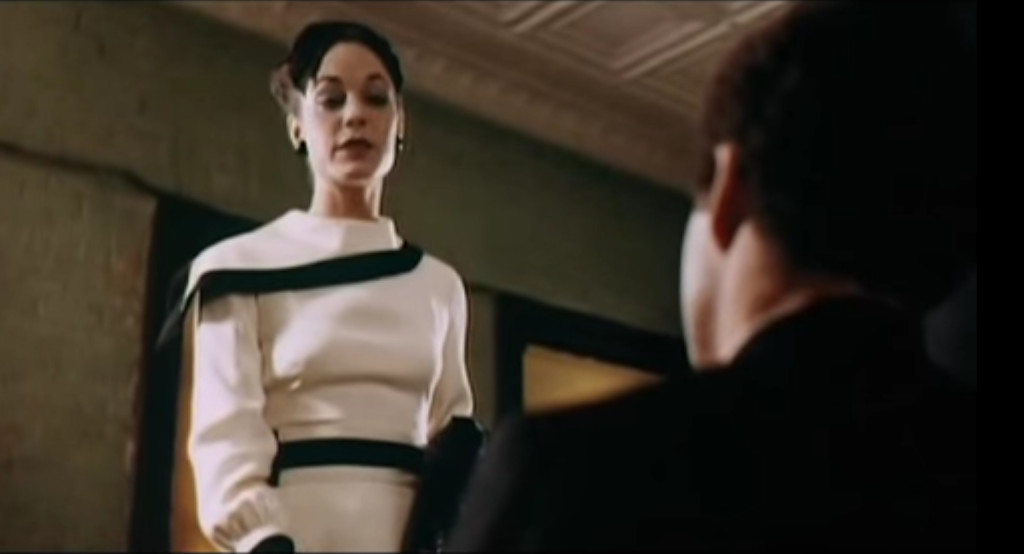
You almost wish you were dead, if Catherine could grace your funeral with this outfit.
Best outfit: There is a lot of standout fashion on display in Alice, Sweet Alice. Who knew Paterson, New Jersey, was such a hotbed of style in 1961? The best outfit of a crowded field of contenders is Catherine’s unusual mourning dress for her ex-husband Dominic: a white (!) dress with black accents and black veil.
Best line: “Okay, Father. We’ll play it your way.” – Detective Mike Spina, conferring with a Father Tom before the police siege
Best kill: Like Vanessa Williams, the movie went and saved the best for last: the fairly unexpected neck stabbing of Father Tom right at the pulpit. Forget “drink of this wine, for it is My blood.” How about just pints and pints of the real stuff?
Unexpected cameo: Most obviously, the film’s first murder victim is played by an extremely young Brooke Shields in her first feature film. Also of note, the actress who plays Alice’s long-suffering mother, Linda Miller, is both the daughter of Jackie (Honeymooners) Gleason and the mother of Jason (Speed 2) Patric.
Unexpected lesson(s) learned: Barring any unforeseen murders, communion rules. Catholics can’t get enough; it’s equivalent to riding shotgun in an Iroc-Z to them. People are shoving each other out of the way to get it, disguising themselves as other children to snag a taste of that host. And if they’re denied it, watch out!
Most suitable band name derived from the movie: Karen’s Veil
Next up: Chopping Mall (1986).
